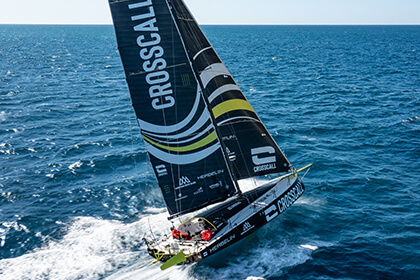
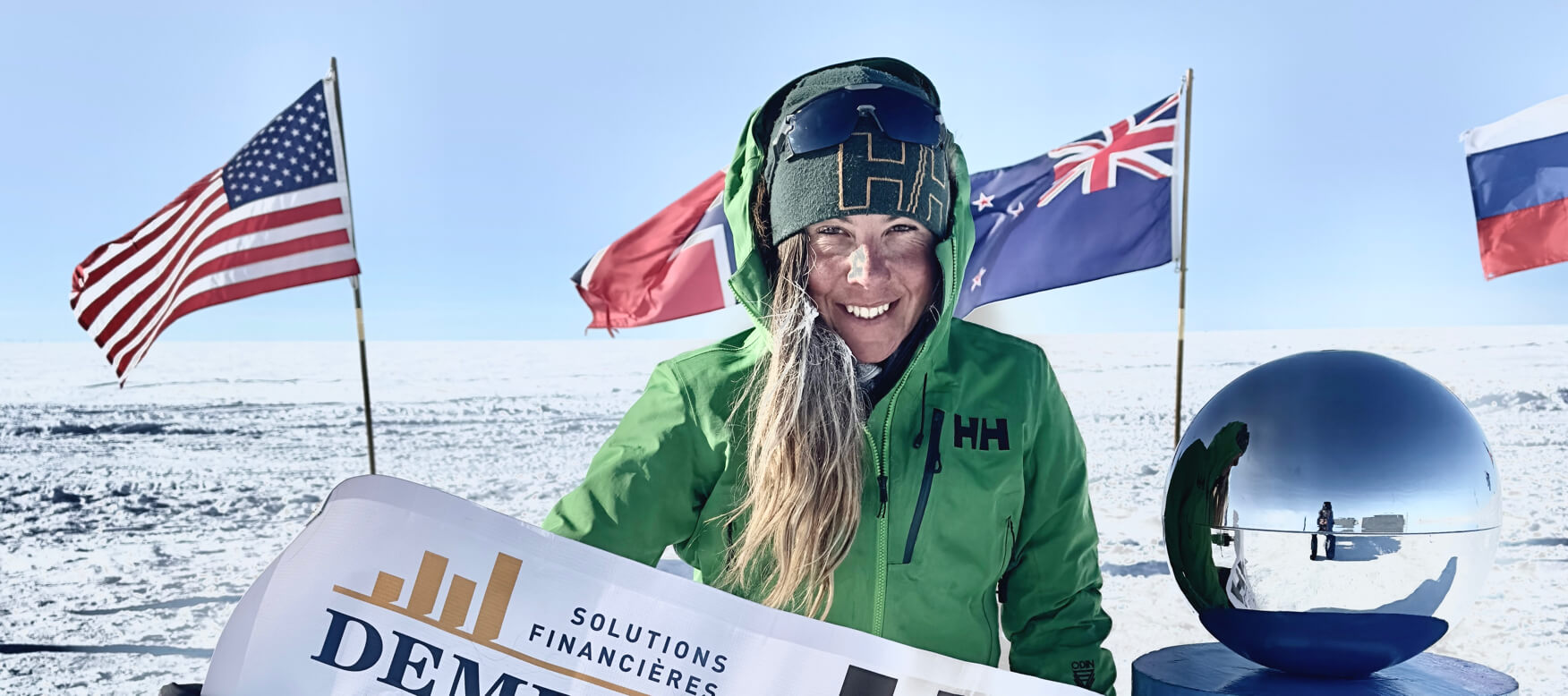
Alone to the South Pole – notes from a record-breaking polar expedition
October 27, 2023
12 min read
On January 11, 2023, Caroline Côté became the fastest woman ever to reach the South Pole with a record-breaking 33 days, 2 hours, and 55 minutes alone and unsupported. Here, she describes what it feels like to push yourself through 1,130 kilometers in the freezing wilderness of Antarctica, shares her ten principles for overcoming difficulties in some of the world’s most challenging conditions, and explains why she does it.
French Canadian Caroline Côté is a professional explorer and endurance athlete with a love for the world’s coldest, most remote places. In 2021, she crossed the Svalbard archipelago for 63 days without supplies and in complete autonomy during the polar winter with her husband and renowned polar explorer Vincent Colliard. She has completed several other expeditions and competed in multiple ultramarathons and high-elevation trail runs worldwide.
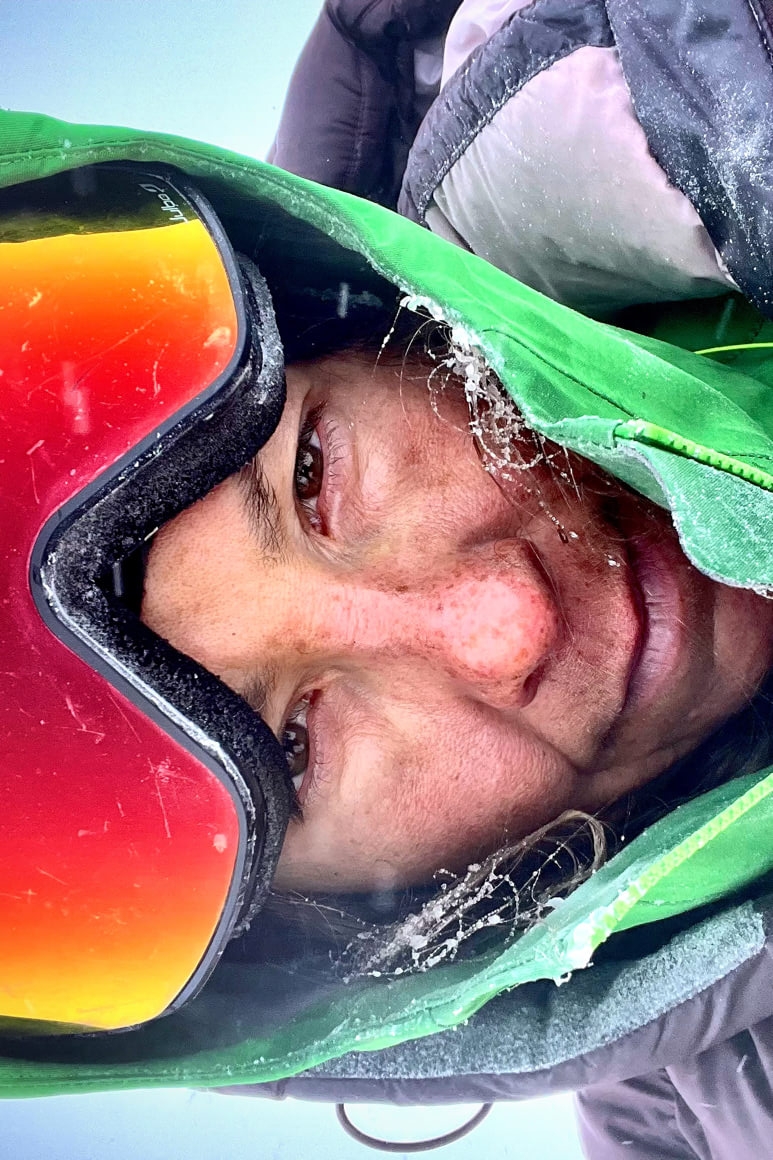
December 9, 2022 – Day 0
I think I'm dreaming when I open my eyes after a restful night. No, I'm not making things up; I'm here in Antarctica. I try to convince myself that I am completely adapted to my environment. The first step is to feel in tune with the cold. It's only -13°C, but I'm pretty chilly at the start of every adventure.
I don't always have the courage to leave my sleeping bag quickly. But I don’t hesitate to put on all my layers of clothing the minute my alarm goes off. This way, I don't let doubt settle in, and no matter how cold it is, I have no choice but to get up. Usually, it works pretty well.
My schedule is simple: I use 2.5 hours to heat the water required for the day on my stove, have breakfast, drink coffee, fold my tent, and put on my skis. The more rigorous I am with my schedule, the more I manage not to waste time. A few minutes of delay each morning can cause me to lose hours and tens of kilometers on the total distance.
The outside light has not changed, and the wind is still calm. These are excellent conditions for a departure. I call the base camp communications team: “Hey. Hi. This is Caro. I'll be leaving in the next few minutes. I'll send you my contact details by message, so you should receive them soon." This way, a message is recorded to Antarctic Logistic Expeditions for my official departure.
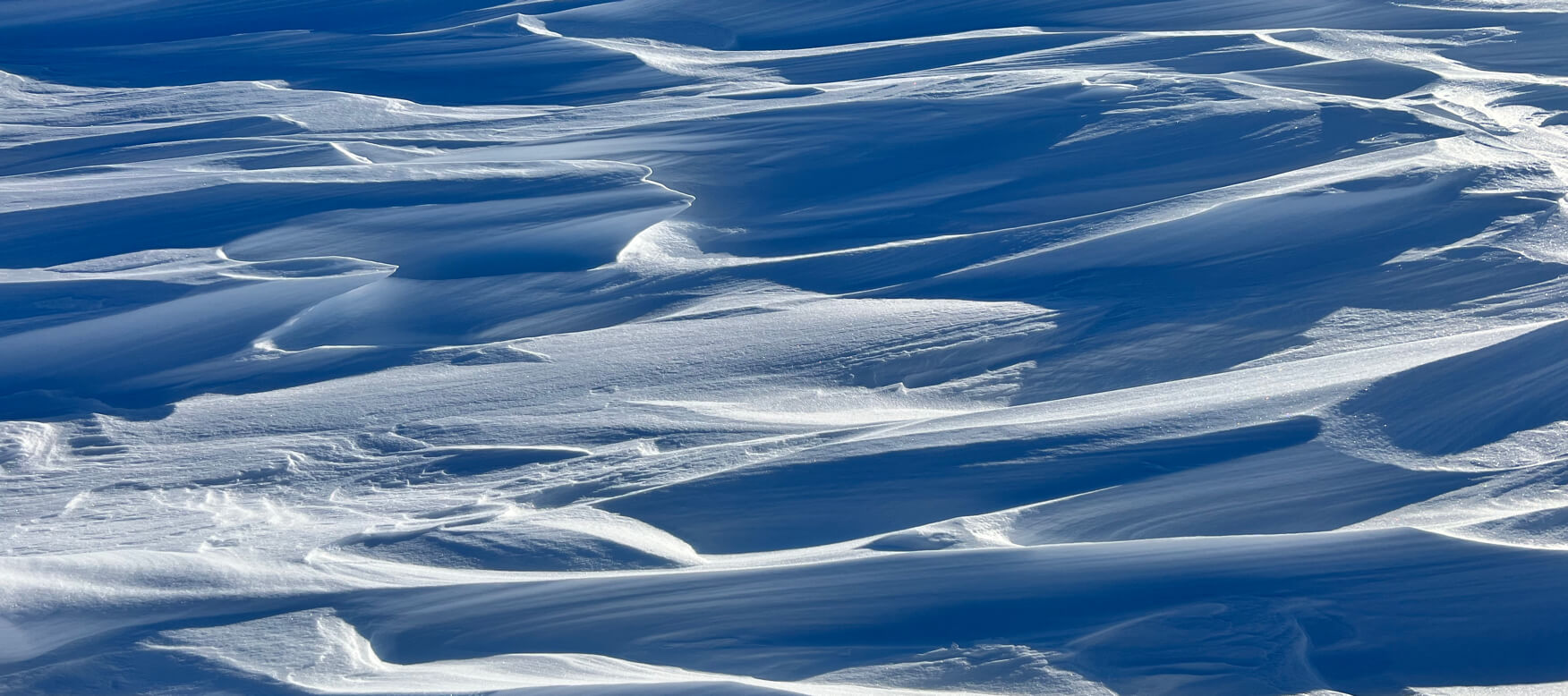
It’s 8:32 a.m.: I’m starting the challenge. Terrified at the idea of moving out on skis and failing, I focus my energy by drawing inspiration from the words of Laurie Anderson, an American experimental artist and musician.
With each step, you fall forward slightly
And then catch yourself from falling
Over and over, you’re falling
And then catching yourself from falling
And this is how you can be walking and falling
At the same time
Laurie Anderson, Walking & Falling, 1982.
I understand that everything should happen naturally and fit into the order of things. Maybe I'm making life too complicated and putting too much pressure on myself for no reason. The idea of falling or making mistakes should become natural to me. Why be afraid of it? I think we all fear being truly alone in the universe, and I realize that. My skis slide forward. That's it! I'm in full swing, and nothing can stop me. I’m suddenly filled with a confidence of iron and ice.
For me, reaching the South Pole is not just about breaking the record; it's also about breaking stereotypes and supporting young women.
The big project of the day will be to establish a good rhythm and to begin to gradually transform myself into a wild animal, like a wolf crossing an untamable territory. I will have to recognize and take ownership of my body's ailments. My back will hurt from the 70-kilo load I'm pulling behind me. My calves and thighs will be filled with lactic acid from the repeated movement. Training begins now. It’s not the days of pre-expedition trail running that will allow me to accomplish the required kilometers for the day. Nothing compares to the reality of the ground I find myself on.
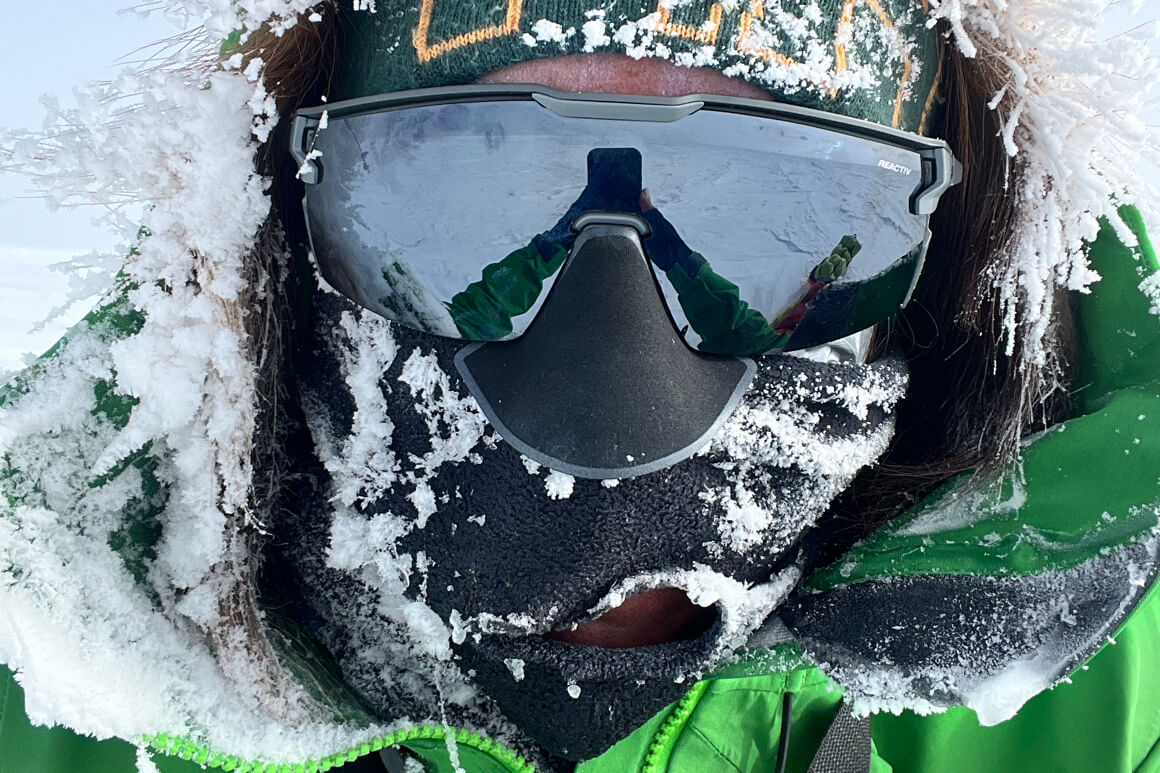
The first hours pass quietly. I feel free and happy not to worry about polar bears because there aren't any. There are no other predators or anyone to bother me or stop me from passing. The way is clear. There are no traffic lights or one-way streets, traffic or horns, no complex routes between buildings, or use of Waze or Google Maps possible. I enter into the disorganization of white nature. I leave aside what I know about the society I usually live in, where everything is organized in chaotic systems.
Everything is so simple here that I feel happy and light. I make sounds and hear my voice in the silence. I don't know exactly what I'm shouting; it doesn't make any sense, but I want to express that I am present on the scene and that I exist. I start with little screams: “Ooh? Ah! Wow! Coooouaaa! Wow!” We rarely get the chance to shout in such a way in society, where I quickly feel crazy if I step outside the established framework. I'm so shy at home. But here I am, starting to rediscover the real me. She had hidden herself to fit the expected image of an ordinary girl.
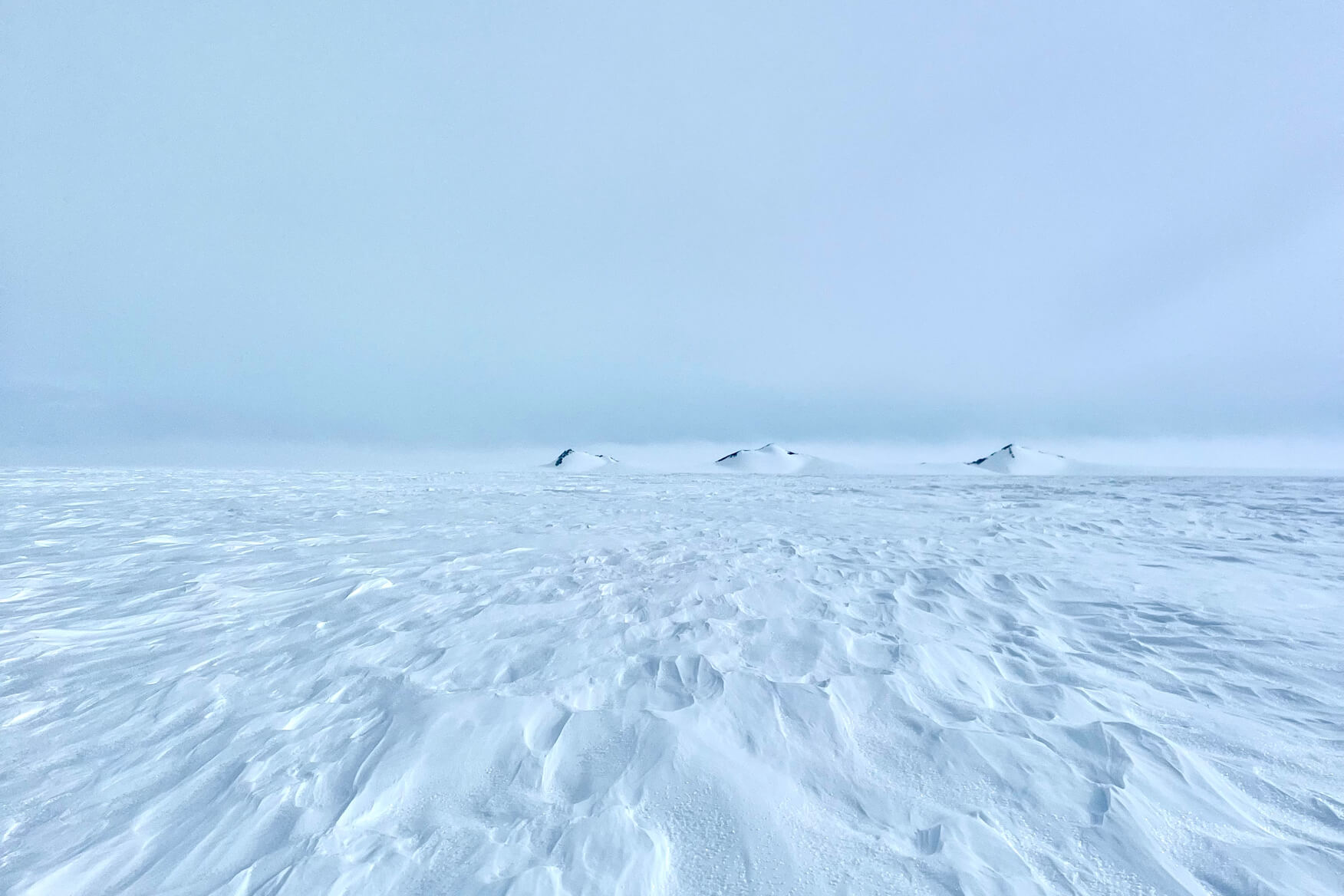
I gain altitude during the first twenty kilometers of the journey, located in the center of the Ronne ice shelf. To the west is the Heritage Range, and to the north is the Ice Rise Skytrain. The first Hercules Inlet expedition to the South Pole took place in 1998 and was led by Martyn Williams. The Mountain guide is the first in the world to lead expeditions to the three extremes: the South Pole, the North Pole, and Everest. He is also the first person to cross the continent of Antarctica by ski unsupported, that is to say, without having received equipment or food along the way.
The slopes south of the area I entered are covered in fields of crevasses, which can make travel dangerous, but studying the maps makes me fairly confident in my abilities in this environment. The climb of this part of the route to reach the plateau quickly calms my boundless energy. It is difficult to stop at a specific time. Normally, I set up my tent when the sun goes out, but here, where it never sets at this time of year, I have to give myself an hour's break.
This evening, I stop my progress at 6 p.m., I’ve had enough. I want to save my energy for the next day. Will entering my shelter make me feel at home? Will I feel reassured and comfortable in this small space?
I don't have a well-established routine yet. I place my equipment under the thin fabric of the tent, and I put my sled in front of it, at a distance of about four meters, to be sure that it will not be buried when I wake up in the morning. In polar environments, you can never predict what will happen without being on the lookout. The snow can pile up around my tent, and I can spend long minutes looking for and digging up what I leave outside. I attach everything I need to a rope connected to my tent.
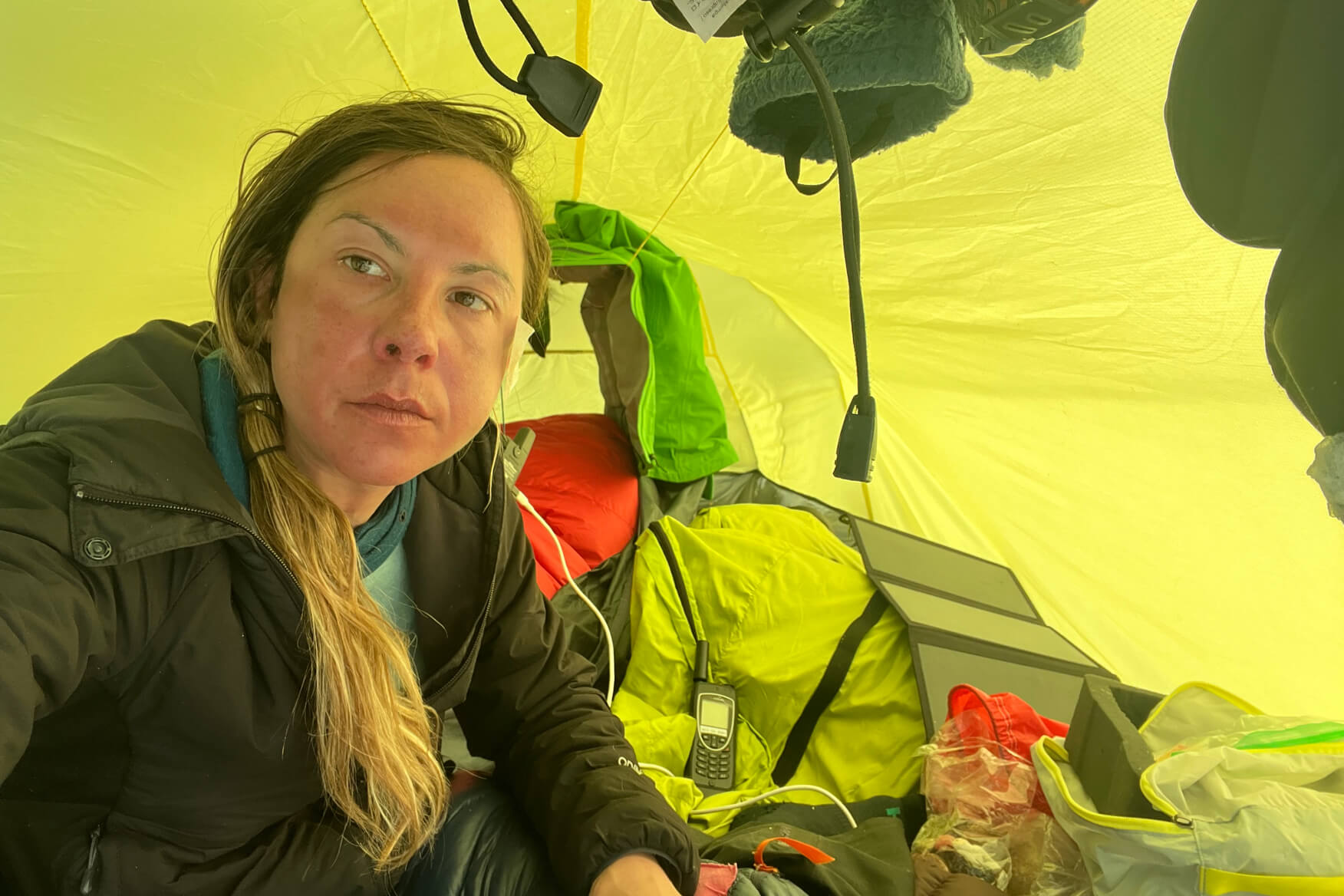
December 14, 2022 – Day 5
The ice mounds in the area I am in are quite large. I go up and down small hillocks in an infinite labyrinth. The thousands of natural ice barriers prevent me from moving forward quickly. Each small projection brings my sled up, and when it comes down, the weight gives a blow to the elastic of the rope that joins my harness. Every bump is like a kick to the hips. Like a coral reef, the sastrugi take away a lot of energy from me. I have to eat more to get through this ordeal and keep calm.
The skis I use are light and efficient. I love them. But this morning, the binding that binds them to my boots is torn from them. I can't stand the stress. I am in shock, and I feel destabilized. It’s day 5! I haven't even been on the road for a week, and I want to move forward. The protrusions in the snow surface probably created a force that twisted my ski during the last few hours. I kneel on the ground. Can I sort this out here in the wind? I want to pray to the ice gods for help, but I can only trust myself.
My skis are equivalent to a soldier's weapon. I have to keep them in good condition. I failed! Can I have a second chance? I might be able to fix them, but not right away. So I will have to walk for the next few kilometers.
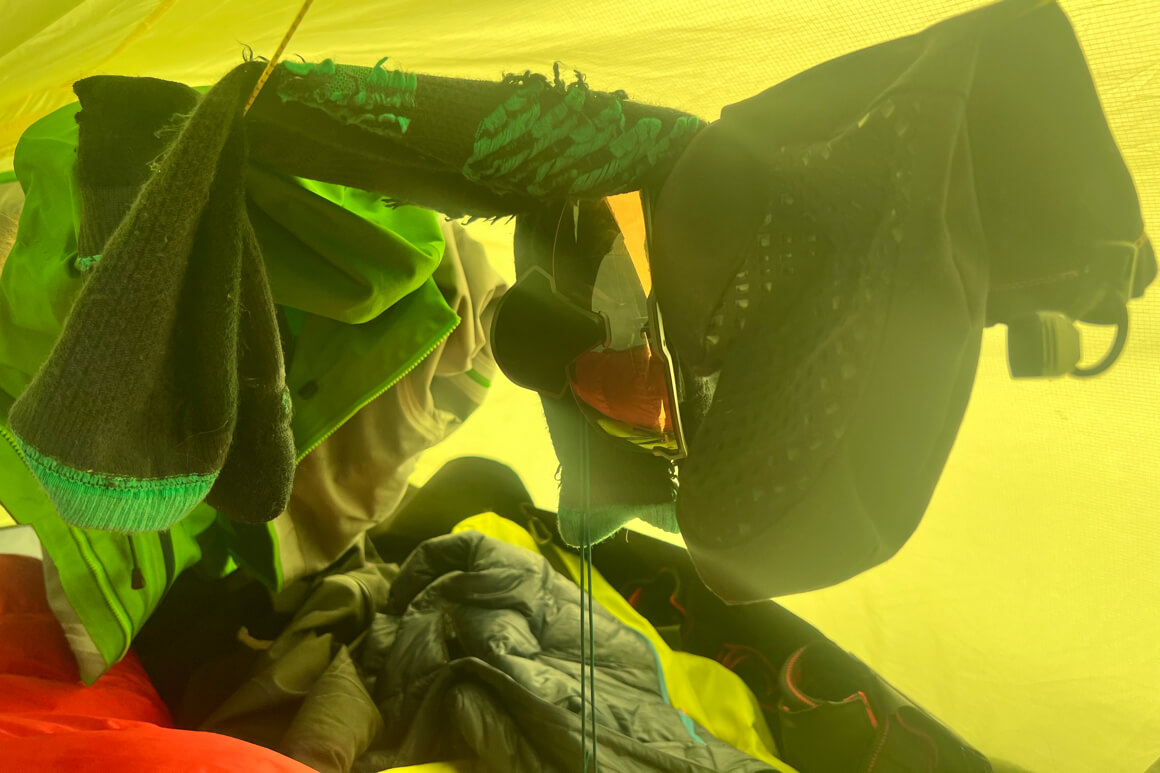
Hours pass. I am inside my shelter and take out my repair equipment. This is a big challenge to overcome! I use a powerful glue. I'm glad I brought it. Repairing a ski may seem simple enough, but in a tent on the snow and with everything I have to do in the evening to eat and prepare for tomorrow, it means that I will have to delay my bedtime by several hours.
Sanding and removing glue takes a lot of time. I then have to apply the adhesive under the fixation very carefully. I have a lot of doubts. Repairing a ski with glue... really? I have to experiment. I try to accomplish my other tasks but fall asleep and leave my tent in a terrible state. I lost control a little tonight. It's late.
When I wake up, my first instinct is to get out of my sleeping bag and reach for my ski. It seems to be holding up! Amazing! The glue dried overnight. I'm relieved but not too quick to rejoice. I'm going to slide to avoid arching it. This will be quite difficult, given the terrain that even a Ford 4 X 4 truck would have difficulty crossing. I'll see what the day has in store for me! At best, or worst, I repaired to the best of my ability and learned a ton.
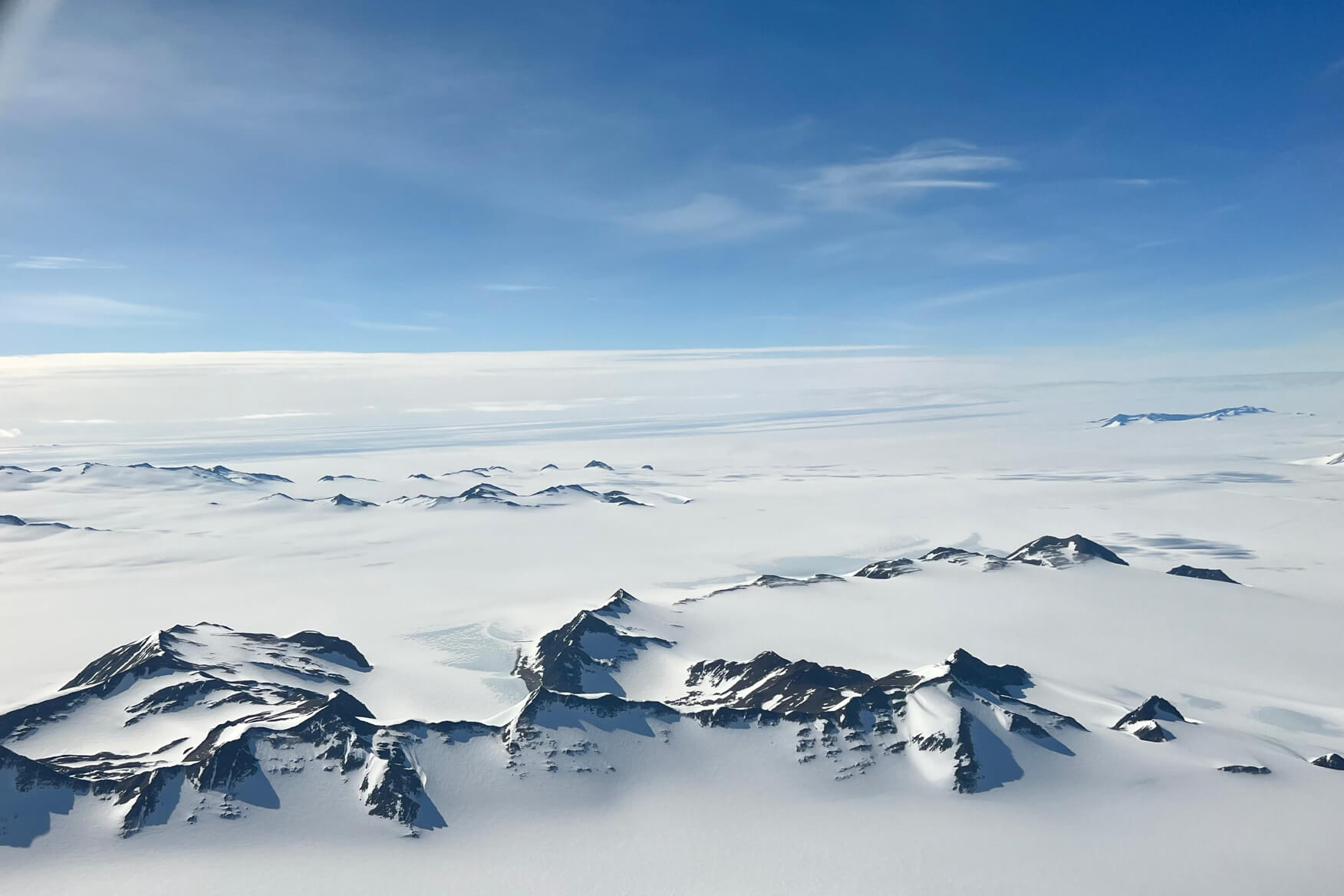
December 16, 2022 – Day 7
The effort of the previous days is starting to take its toll on my body and my thoughts, and I already feel the effect of solitude tickling my mind during the second half of the day. I expected this to happen, and I use tools that help me overcome my frequent urges to give up. The method I have implemented is based on ten principles that help me to face moments of great difficulty during expeditions:
1. Listen to audiobooks or music
This allows me to have fun and forget about my daily efforts. I like artists who remind me of the region where I come from, who bring me memories of my environment, podcasts by Quebec comedians, and tales and legends that make me dream. Sometimes, I like to free myself from the cold and the snow and remember that there is also summer. The songs that take me on a journey help me escape.
2. Use positive anchoring in images
My friend Anne, a long-distance trail runner, recently suggested bringing images or objects when I carry out an endurance activity. She brings a page from the book Territoires Inconnus de Patrice Godin (Libre Expression, 2015, 160) everywhere during the different racing events she participates in. Here is an excerpt of what we find on this page that inspires her:
Doubt. You doubt, of course. Doubt is a damn beast. It eats you from the inside, it interferes in your veins, drowns your heart. It takes your breath away, it cuts your legs. So don't doubt. Advance. Do not look back.
In her bag, she also keeps a drawing of her daughter Charlotte. These two pieces of paper, which may seem very simple, are full of meaning for her and push her to surpass herself, to go further. These are its positive anchors.
3. Have fun
Remember to complete the tests with pleasure and passion, like a child having fun playing a game.
4. Eat
Eating, of course, but also taking snack breaks or special meals is warming my heart. It’s simple but so effective.
5. Accept obstacles
The expedition will definitely not go as planned. Things will probably get out of hand. Adaptability in the face of unforeseen circumstances must become an acquired characteristic of my personality.
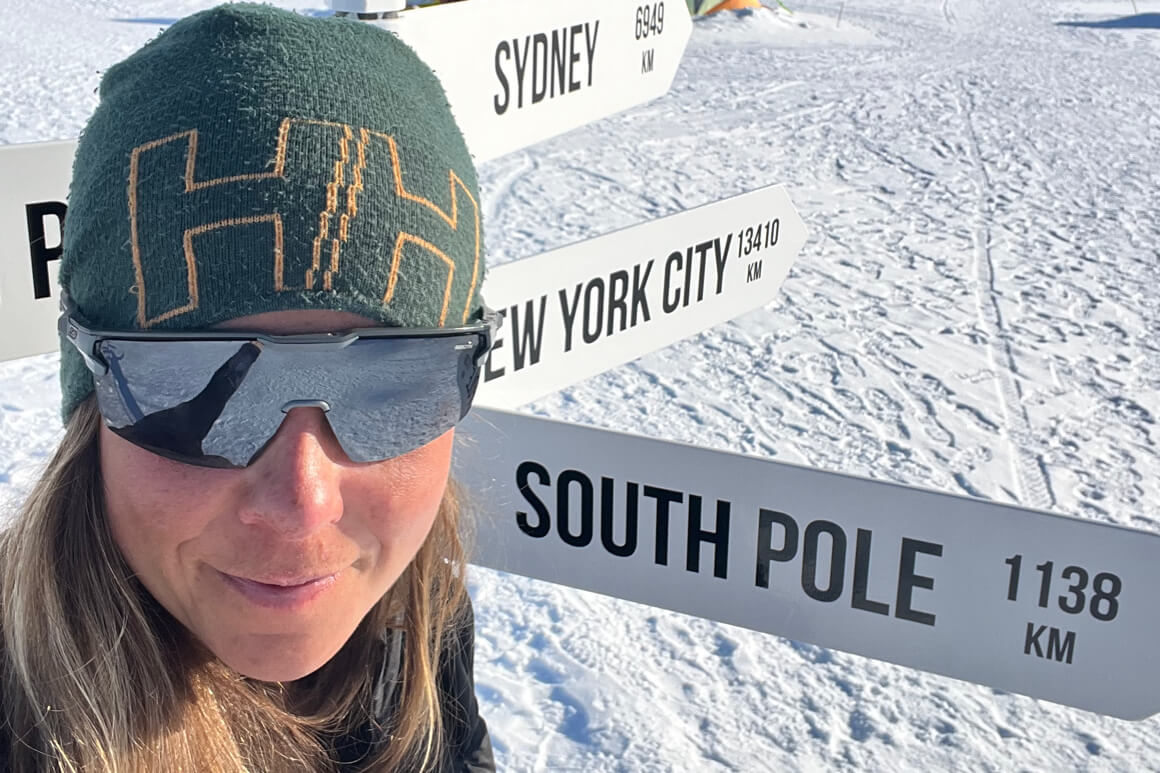
6. Establish a routine
Establish a simple operating mechanism that is easy to follow when conditions become more difficult. This is a method acquired to leave no room for the unexpected.
7. Remain flexible in the face of unforeseen circumstances
Despite my fear of hitting a storm and wasting a day cooped up in my tent, I must stop torturing my mind with this because I have no control over the weather.
8. Understand that failure does not define me
I have to remember that one mistake on my part does not make me “a failure.” On the contrary, it makes me a better person. Many small obstacles can guide me toward the success of my challenge if I don't give up.
9. Remind myself why I undertook this challenge
In a complex situation, I will be led to question my choices. Is it the right decision to find myself in Antarctica, far from everything and in a hostile environment for a month? I will probably have a lot of doubts about my ability to move forward, which is entirely normal. What will give me the strength to overcome these fears will be to find the reason and value of my project and then decipher its meaning.
As leadership expert Simon Sinek mentions in his lecture How Great Leaders Inspire Action, without a specific goal, it is not easy to overcome challenges if the fundamental driving force of our project is not clearly founded. What is the origin of my great mission? It's not just about getting to the end of these 1,130 kilometers.
For me, reaching the South Pole is not just about breaking the record; it's also about breaking stereotypes and supporting young women. I've been inspired by so many of them, and now I want to support them. I don't want them to compete but to grow together as a community. I think it's vital, and I think it defines the “why” of my expedition.
10. Dream big
The goal is not just to cross the finish line. What I remember from my experience of long-term adventure is that you can learn at each stage, from preparation to the challenge achieved. By investing from day one until the end, we become stronger. Some leave tears, sweat, and failures, but in the end, we refine our courage, vision, discipline, and motivation throughout the adventure, not just on the podium or when we pass the finish line. We can, therefore, feel like we are winning by getting involved from the start of a project, even when we don’t know how it will end.
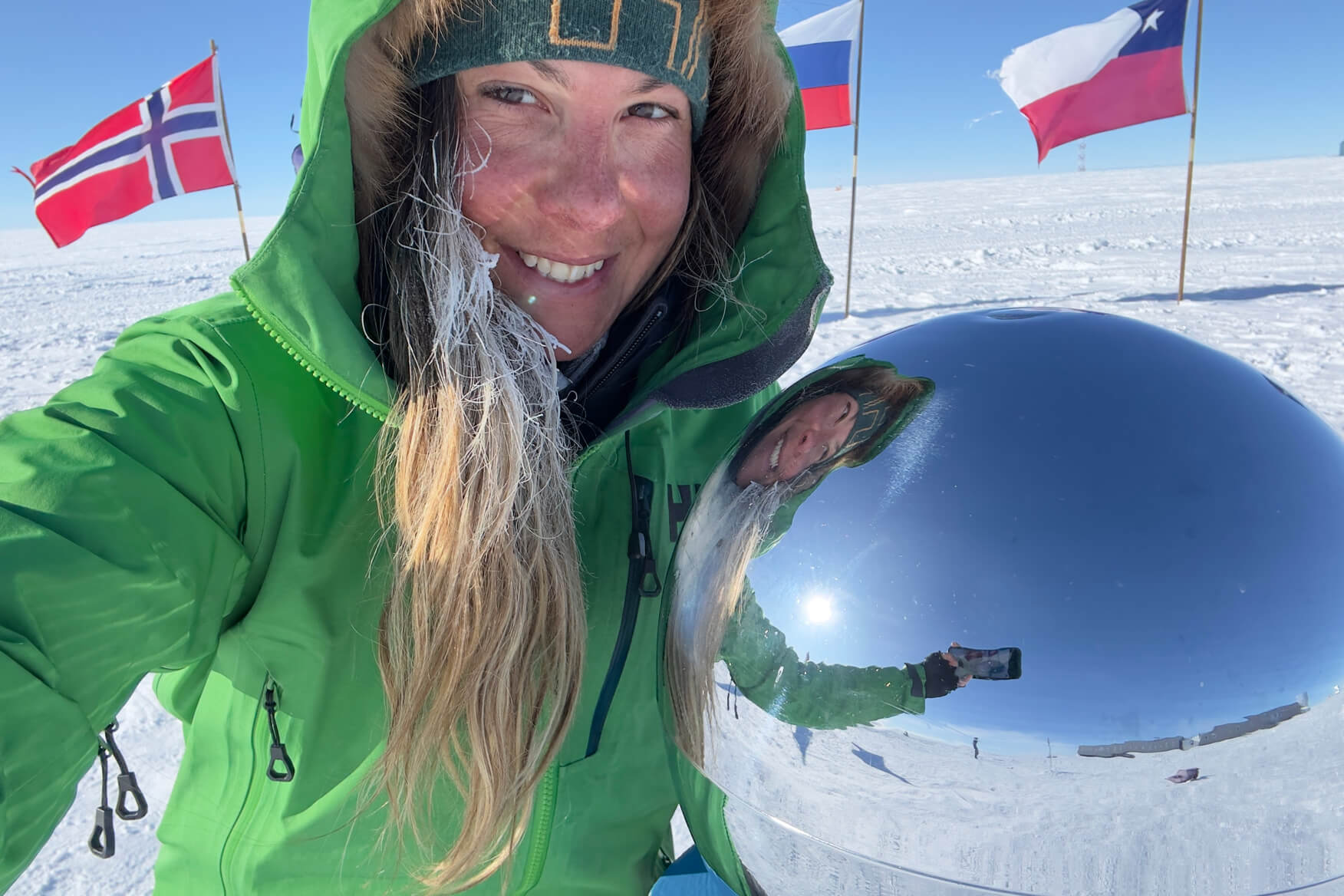
January 11, 2023 – Day 33
1.2 kilometers from the finish, I see the poster of my penultimate GPS point. On the poster, I read: “Congratulations! You are almost at the South Pole.” I put away the compass, which never let go of me during the journey. I only have a few minutes left to spend with myself before I have to speak again. This thought makes me sad because I fell in love with these icy landscapes. I feel good. I adapted to it.
The calm of the place calms me now, even if it initially scared me. I don't want to leave behind this vast place which welcomes me and allows me to experience some of the best moments of my life. I finally adapted to this lifestyle. I stop and take a break. I am not ready. I have to let go of this lonely me.
I am now ready to return to those who supported me and who I miss. I have the pleasure of seeing it arrive on the horizon, around 11 a.m., near the pole camp area! I am extremely slow. I gave everything, like at the end of a big race. The South Pole. It’s a special place beyond what the mind can imagine. I had seen a few images of flags flying around a flagpole, but it is so much more than that.
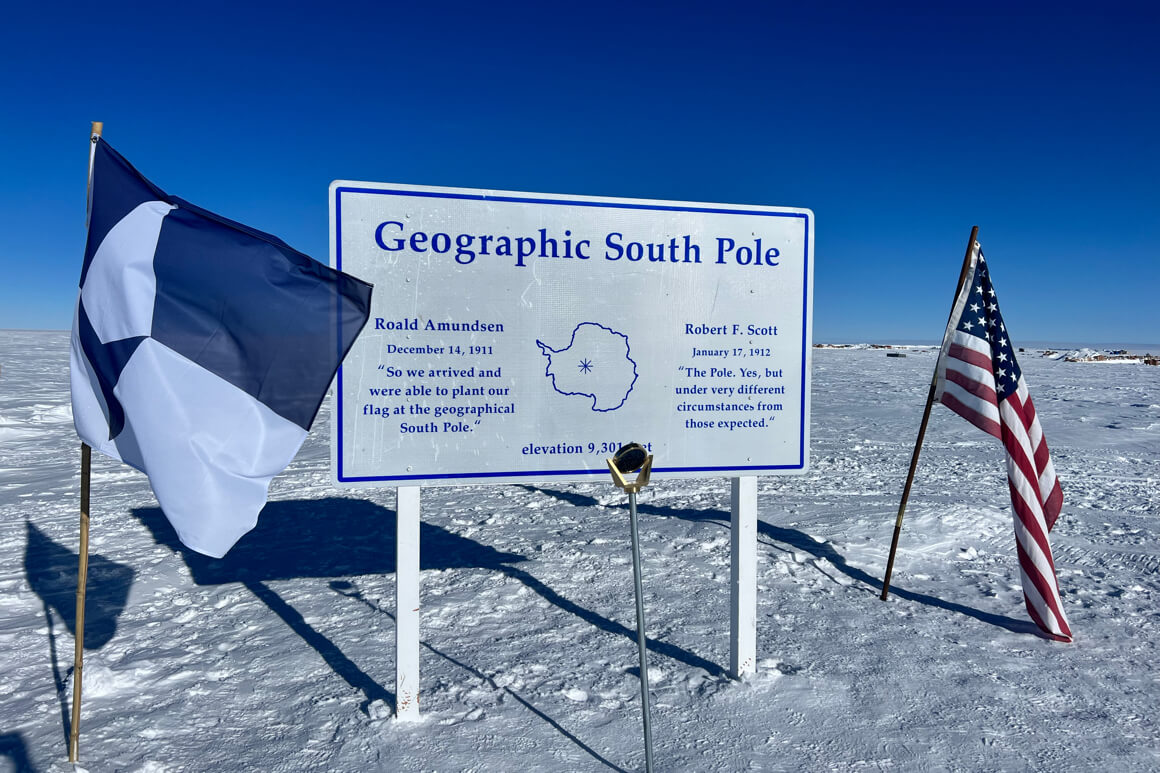
Returning home
Accompanied by great memories, I return to Quebec, where the coolness of winter is still well established, and the shivers that run through my body remind me that I am alive. It’s a different cold, more humid, denser than that of Antarctica, it seems to me. I quickly find myself immersed in an urban flow.
We carry within each of us the capacity and power to dream. I like to encounter the unpredictable and the challenges nature brings me. These elements create marks on my aging body. Like the bark of a tree following the movements of the wind, I adapt to what happens in front of me; I learn every day. The successful expedition in collaboration with my team makes me proud and happy. It's a simple and unique experience I would never have had otherwise!

The future of Antarctica
Glaciers are precious and guarantee an irreplaceable balance for our planet. It is now up to us all to ensure their sustainability for future generations. The countdown has already started, and every action counts. It's not up to others to make things happen; it's our turn to take action. We have a responsibility to answer for the actions we take. I usually like to speak softly without being disruptive, but there is a purpose to my words and actions. Reaching the end of this long journey allows me to have a voice on what is important to me. This continent on which I had the chance to set foot, I cherish it more than anything, and I want to protect it.
In 2041, the future of Antarctica will be decided. The treaty that protects it, signed in 1941, was designed to ensure that Antarctica remains unexploited and preserved as a land of peace and science. This treaty is due to be revised in 2041. Some countries could try to claim a piece of Antarctica for exploration, drilling, and poaching.
follow caroline:
Caroline's clothing on the expedition:

Women's Odin 9 Worlds Infinity Shell Jacket

Women’s Odin Mountain Infinity 3-Layer Ski Salopette

Women's Verglas Glacier Down Jacket

Women's LIFA® Merino Midweight 2-In-1 Base Layer Pants

Unisex Outline Beanie Hat

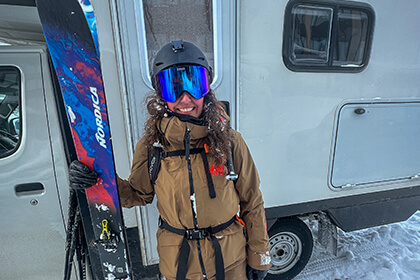
October 21, 2025 10 min read
How to plan your ski trip to Japan
Skiing Japan with Nat Segal: Hokkaido RV adventure, volcano tours, and how to thrive through a dry spell.
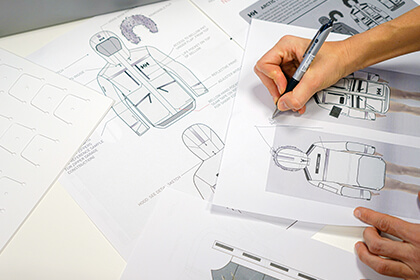
September 29, 2025 4 min read
Behind the design: The Arctic Patrol Down Parka
An inside look at how Helly Hansen designed the Arctic Patrol Down Parka with insights from Arctic scientists for extreme conditions.